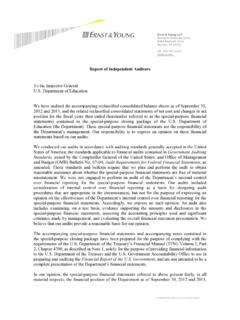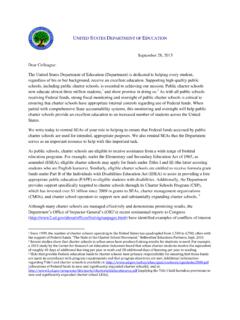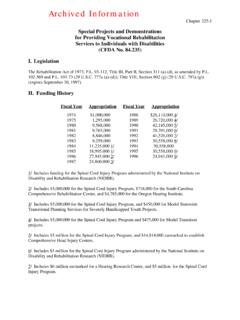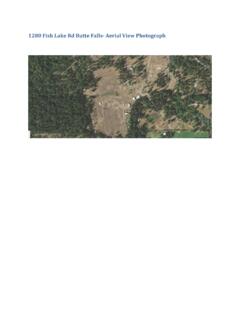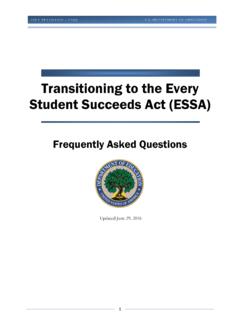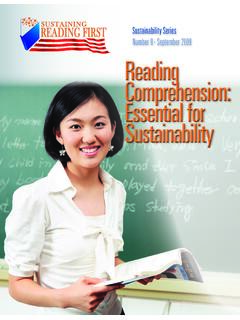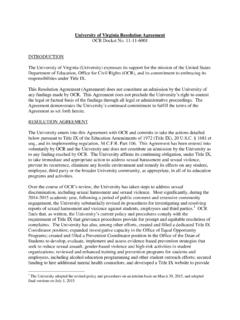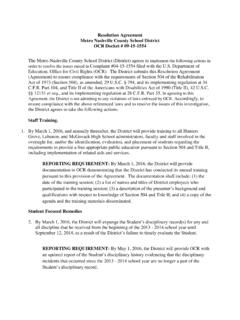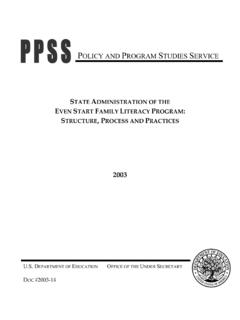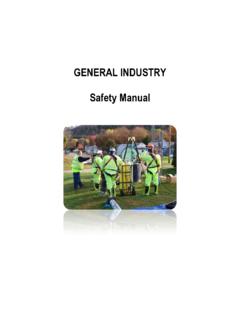Transcription of The Final Report and Findings of the Safe School ...
1 THE Final Report ANDFINDINGS OF THESAFE SCHOOLINITIATIVE:IMPLICATIONS FORTHE PREVENTION OFSCHOOL ATTACKS INTHE UNITED STATESUNITED STATES SECRET SERVICE ANDUNITED STATES DEPARTMENT OF EDUCATIONWASHINGTON, D. 2004 iTHE Final Report AND FINDINGSOF THE SAFE School INITIATIVE:IMPLICATIONS FOR THE PREVENTION OFSCHOOL ATTACKS IN THE UNITED STATESUNITED STATES SECRET SERVICEANDUNITED STATES DEPARTMENT OF EDUCATIONbyBryan VossekuilDirectorNational Violence Prevention and Study CenterRobert A. Fein, Violence Prevention and Study CenterMarisa Reddy, Research Psychologist and Research CoordinatorNational Threat Assessment Secret ServiceRandy Borum, ProfessorUniversity of South FloridaWilliam ModzeleskiAssociate Deputy Under SecretaryOffice of Safe and Drug-Free Department of EducationWashington, D. 2004 PREFACEiiiJOINT MESSAGE FROM THE SECRETARY, DEPARTMENT OFEDUCATION, AND THE DIRECTOR, SECRET SERVICEL ittleton, Colo.; Springfield, OR; West Paducah, KY; Jonesboro, AR.
2 Thesecommunities have become familiar to many Americans as the locations where schoolshootings have occurred in recent years. School shootings are a rare, but significant,component of School violence in America. It is clear that other kinds of problemsare far more common than the targeted attacks that have taken place in schoolsacross this country. However, each School -based attack has had a tremendous andlasting effect on the School in which it occurred, the surrounding community, and thenation as a whole. In the aftermath of these tragic events, educators, lawenforcement officials, mental health professionals, parents, and others have asked:"Could we have known that these attacks were being planned?" and "What can bedone to prevent future attacks from occurring?"In June 1999, following the attack at Columbine High School , our two Secret Service and the Department of Education--launched a collaborativeeffort to begin to answer these questions.
3 The result was the Safe School Initiative,an extensive examination of 37 incidents of targeted School shootings and schoolattacks that occurred in the United States beginning with the earliest identifiedincident in 1974 through May 2000. The focus of the Safe School Initiativewas onexamining the thinking, planning, and other behaviors engaged in by students whocarried out School attacks. Particular attention was given to identifying pre-attackbehaviors and communications that might be detectable--or "knowable"--and couldhelp in preventing some future attacks. SAFE School INITIATIVEFINAL REPORTiiThe Safe School Initiativewas implemented through the Secret Service s NationalThreat Assessment Center and the Department of Education s Safe and Drug-FreeSchools Program. The Initiativedrew from the Secret Service s experience instudying and preventing assassination and other types of targeted violence and theDepartment of Education s expertise in helping schools facilitate learning throughthe creation of safe environments for students, faculty, and document, the Safe School Initiative s Final Report , details how our two agenciesstudied School -based attacks and what we found.
4 Some of the Findings may surpriseyou. It is clear that there is no simple explanation as to why these attacks haveoccurred. Nor is there a simple solution to stop this problem. But the Findings ofthe Safe School Initiativedo suggest that some future attacks may be preventable ifthose responsible for safety in schools know what questions to ask and where touncover information that may help with efforts to intervene before a School attackcan it began in June 1999, our partnership has been a tremendous asset to each ofour respective agencies and vital to the success of this study. It is our hope that theinformation we present in this Final Report is useful to those of you on the front linesof this problem the administrators, educators, law enforcement officials, and otherswith protective responsibilities in schools and to anyone concerned with children ssafety. We encourage all of you in your efforts to keep our nation s children safe inschool and hope this Report helps you in those PaigeW.
5 Ralph Department of Secret ServiceACKNOWLEDGMENTSvACKNOWLEDGMENTSTh e Secret Service and the Department of Education are grateful to manyagencies and individuals for their assistance in planning and carrying out the SafeSchool and foremost, the authors of this Report owe a debt ofgratitude to the representatives of the numerous law enforcement and criminaljustice agencies that permitted Secret Service personnel to review investigative fileson the School attacks in their respective communities; provided other keyinformation and materials relating to these attacks; and assisted and supportedSecret Service personnel in seeking permission to interview 10 attackers. Moreover,the authors are grateful to the Department of Justice, Office of JusticePrograms National Institute of Justice for providing critical financial support thathelped make the study addition, Secret Service and Department of Education personnel benefitedsubstantially from the contributions of several law enforcement, behavioral scienceand mental health professionals whose collective experience and expertise helped toinform the development of the project plan and research design.
6 In alphabeticalorder, these individuals are: Gerardo Blue, Frederick Calhoun, Charles Ewing,Michael Gelles, Dennis McCarthy, Edward Mulvey, William Pollack, Larry Porte,Pam Robbins, Raymond Smyth, Sara Strizzi, and Andrew Vita. This project would not have been possible without the support and guidance that theauthors received from several key officials and personnel at the Department ofEducation and the Secret Service. Absent the expertise and insights of theseindividuals, the Secret Service s experience in researching and preventing targetedviolence could not have been translated into a useful study of targeted schoolSAFE School INITIATIVEFINAL Report violence. At the Department of Education, these individuals are: Secretary ofEducation Rod Paige, former Secretary of Education Richard Riley and ConnieDeshpande. Secret Service officials who provided guidance and support for thisproject are: Director Brian Stafford, Assistant Director Terry Samway, DeputyAssistant Directors Bob Byers and Tom Riopelle, Special Agent in Charge GeorgeLuczko and Resident Agent in Charge John Berglund.
7 Special thanks are extendedto Social Science Research Specialist Karissa Kumm who assisted with project datacollection and was instrumental in organizing information from the Safe SchoolInitiativekick-off meeting. Our thanks go also to Dean Terry, Michael Gelles andMarty Allen for providing extensive assistance with project data collection. The authors extend special thanks to Assistant Director Barbara Riggs, Office ofProtective Research, Secret Service, for her support of the Safe School Initiativeand the National Threat Assessment authors wish to thank Assistant Special Agent in Charge Matt Doherty, Assistantto the Special Agent in Charge Cindy Rubendall and Special Agent Ignacio Zamorafor giving generously of their time in reviewing earlier drafts of this document, andformer Special Agent Nancy Fogarty, Social Science Research Specialists DerrickaDean and Megan Williams and interns Marissa Savastana, Becca Norwick andColleen Spokis for their invaluable assistance with data collection, data entry andproject , the Secret Service and the Department of Education gratefully acknowledgethe contributions of Paul Kelly and Gwen Holden of the Nauset Group, whoseinsightful observations and comments helped to shape the Final Report .
8 Specialthanks go out to Gwen Holden, who edited the Final Vossekuil Robert Fein Marisa Reddy Randy Borum William ModzeleskiWashington, 2002ivTABLE OF CONTENTSviiCHAPTER I:INTRODUCTION: THE SAFE School INITIATIVE..1 The Safe School Initiative..3 Defining "Targeted" School Violence ..4 The Secret Service Threat Assessment Approach ..4 The Prevalence of Violence in American Schools ..6 Methodology ..7 The Study Population ..8 Sources of Information on Incidents ofTargeted School Violence ..8 Coding of Primary Source Materials..9 Analysis of Responses to the Coded Study Questions ..10 Organization of the Final Report ..10 Overview of Safe School InitiativeFindings ..11 CHAPTER II:CHARACTERISTICS OF INCIDENTS OF TARGETED School VIOLENCE ..13 Target and Victim Characteristics ..16 CHAPTER III: Findings OF THE SAFE School INITIATIVE..17 Characterizing the Attacker ..19 Conceptualizing the Attack ..23 Signaling the Attack.
9 25 Advancing the Attack ..26 Resolving the Attack ..27 CHAPTER IV:IMPLICATIONS OF SAFE School INITIATIVEFINDINGS FOR THE PREVENTION OFTARGETED School VIOLENCE ..29 The Implications of Key Study Findings ..32 CHAPTER V:CONCLUSION: THREAT ASSESSMENT AS A PROMISING STRATEGY FOR PREVENTING School VIOLENCE ..39 Threat Assessment and Targeted School Violence Prevention ..41 APPENDIX A:INCIDENTS OF TARGETED School VIOLENCE,BY STATE ..45 APPENDIX B:INCIDENTS OF TARGETED School VIOLENCE,BY YEAR ..47 APPENDIX C:RESOURCES ..49 CONTACT INFORMATION ..51 SAFE School INITIATIVEFINAL REPORTviSAFE School INITIATIVEFINAL Report viiiCHAPTER I- INTRODUCTIONCHAPTER IINTRODUCTION:THE SAFE School INITIATIVECHAPTER I- INTRODUCTION3 Littleton, CO; Springfield, OR; West Paducah, KY; Jonesboro, AR. Thesecommunities have become familiar to many Americans as among the locations ofthose schools where shootings have occurred nationwide in recent years.
10 In theaftermath of these tragic events, educators, law enforcement officials, mental healthprofessionals and parents have pressed for answers to two central questions: "Couldwe have known that these attacks were being planned?" and, if so, "What could wehave done to prevent these attacks from occurring?" This publication, The Final Report and Findings of the Safe School Initiative:Implications for the Prevention of School Attacks in the United States, is a recentproduct of an ongoing collaboration between the U. S. Secret Service and the U. of Education to begin to answer these is the culminationof an extensive examination of 37 incidents of targeted School violence that occurredin the United States from December 1974 through May Safe School Initiative Following the attack at Columbine High School in April 1999, the Secret Service andthe Department of Education initiated, in June 1999, a study of the thinking,planning and other pre-attack behaviors engaged in by attackers who carried outschool shootings.
